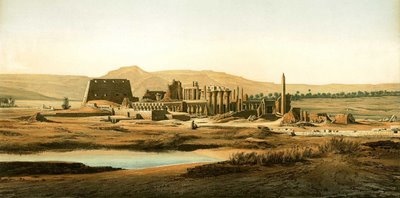















 [click for much large versions - scaled down a little and touched up for background artifact]
[click for much large versions - scaled down a little and touched up for background artifact]It is no small coincidence that two of the pioneers of egyptian archaeology were inclined towards linguistics. Jean-François Champollion (previous post) was given the opportunity to decipher the Rosetta Stone because of his gift for languages, following which he developed an interest in the antiquities of Egypt. He spent a year there in 1828 with a Franco-Italian mission and his egyptian hieroglyphs interpretations were released after his death at a young age.
Prussian Karl Lepsius (1810-1884) on the other hand, studied European archaeology for a doctoral degree. He was then introduced to the Champollion translation work by a tutor and thereafter applied himself to further deciphering the egyptian language. He spent some years travelling around Europe, studying egyptian artifacts and educating himself in hieroglyphs. He visited Champollion's expedition partner, Ippolito Rosellini, in Italy and published his own improvements on the initial translation analysis. Later, he would develop an alphabetical system for transliterating african languages.
On the advice of Alexander von Humboldt, the Prussian King sent Lepsius with an expedition in 1842 to study the egyptian/nubian/ethiopian monuments and to bring back any treasures discovered. The mission would last for 4 years and the party made detailed surveys of a vast number of ancient structures ranging from Alexandria in the north as far south as Khartoum in the Sudan.
Artists and mould makers accompanied the expedition and nearly 900 illustration plates were ultimately engraved for a massive 12 volume series recording their findings. Lepsius brought back 15,000 (!) individual pieces from the tour, including columns and walls dynamited by the ruler Muhammad Ali and given as a present during a ceremonial dinner. The texts themselves remain primary documents in egyptology and in cases where buildings and artifacts were destroyed (as was inevitably the case, back then), they remain as the only surviving record.
Lepsius would go on to become a Professor and oversee the egyptian artifacts housed at the Berlin Museum. He ventured back to Egypt later and uncovered the Decree of Canopus, an adjunctive trilingual tablet supporting the Rosetta Stone translation.
2 final points in the trivia stakes:
-- there is only one set of hieroglyphs at the Great Pyramid of Giza. It was carved at the entrance by Karl Lepsius in 1843 (not so trivial really).
-- Lepsius coined the expression 'The Book of the Dead' with his 1842 publication, 'Das Todtenbuch der Ägypten nach dem hieroglyphischen Papyrus'.
- The 12 volumes of 'Denkmäler aus Aegypten und Aethiopen' ('Monuments of Egypt and Ethiopia') bear an 1897 publication date but I presume they were published over many years before that. The full series of plates is most likely available at the Martin Luther University website but it is a timeconsuming task going through page by page - it's both a slow server and all the images are ~300kb in size. I saw perhaps 150 pages, if that. The above samples are a fair cross section, although I didn't include any of the many maps available.
- 'Karl (Carl) Richard Lepsius: A Founder of Modern Egyptology' by Jimmy Dunn.
- 'Das Archivmaterial der Lepsius-Expedition' is a german site and has some original manuscript pages and illustrations (but it is predominantly commentary).
- The face mask image above comes from the Met. Museum.
- The previous 'Monuments of Nubia and Egypt' post has some interesting/relevant links.
No comments:
Post a Comment